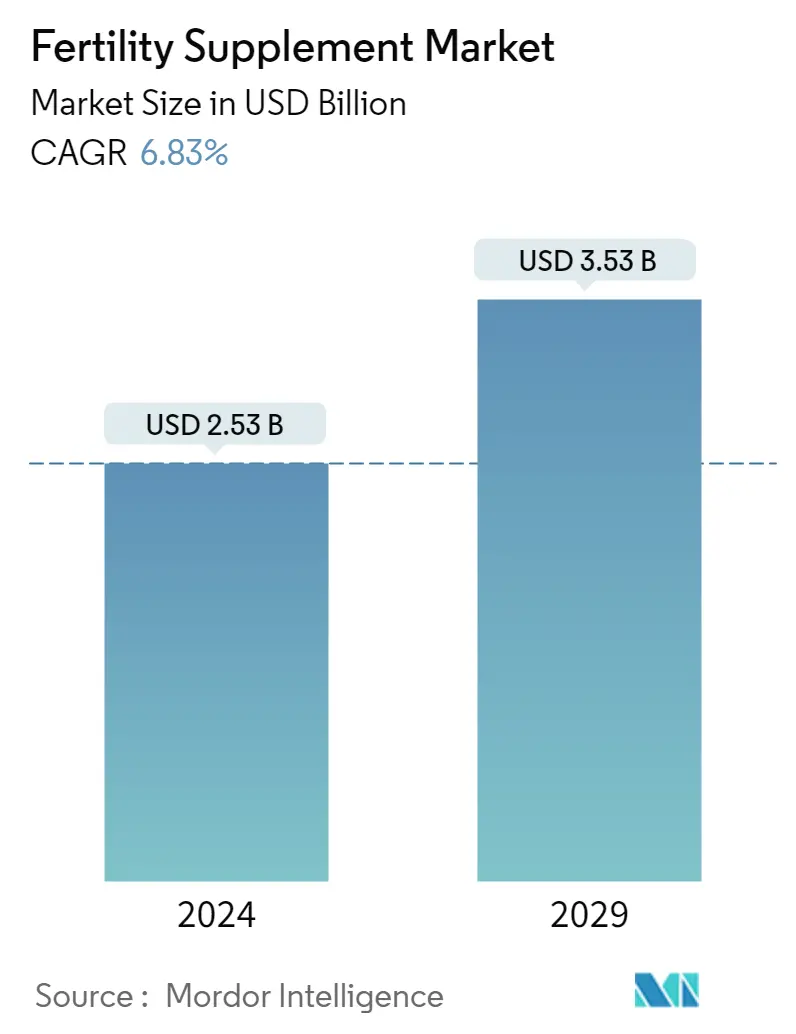Market Size of Fertility Supplement Industry

| Study Period | 2019 - 2029 |
| Market Size (2024) | USD 2.53 Billion |
| Market Size (2029) | USD 3.53 Billion |
| CAGR (2024 - 2029) | 6.83 % |
| Fastest Growing Market | Asia-Pacific |
| Largest Market | North America |
Major Players
*Disclaimer: Major Players sorted in no particular order |
Fertility Supplements Market Analysis
The Fertility Supplement Market size is estimated at USD 2.53 billion in 2024, and is expected to reach USD 3.53 billion by 2029, growing at a CAGR of 6.83% during the forecast period (2024-2029).
The COVID-19 pandemic had a positive impact on the demand for fertility supplements as it was found that the virus had an impact on a person's level of fertility. According to the article titled "Potential Role of Zinc in the COVID-19 Disease Process and its Probable Impact on Reproduction", published in January 2021, zinc supplements can restrict or minimize damage to egg and sperm cells caused by the body's immune response to the coronavirus by enhancing immunity. In February 2021, researchers at the Wayne State University School of Medicine reported that people who were attempting to conceive during the pandemic might have a chance to enhance immunity against the virus. They might also be able to prevent mitochondrial damage in young eggs and sperm cells. Such studies have increased the demand for fertility supplements during the pandemic, thus having a positive impact on the market.
According to an article published in January 2021, zinc supplements help prevent or reduce the damage that the body's immune response to the virus might cause to the egg and sperm cells by boosting immunity. These research and developments have increased the demand for fertility supplements, thus positively impacting the market's growth.
The data published by the CDC, in April 2021, found that female and male factors were identified in 35% of the couples suffering from infertility. Only male factor was identified in 8% of couples suffering from infertility. Thus, the increasing incidences of infertility among men and women are increasing the demand for fertility supplements, which is anticipated to boost the market's growth over the forecast period.
The launch of fertility supplements is also expected to drive the market. For instance, in April 2022, Wellbeing Nutrition launched SLOW, a time-conscious range of nutraceuticals for men and women, which comprises 13 supplements. Each formulation has been specifically designed for a host of unique health and wellness needs, such as fertility support.
However, the government regulations to control birth rate and lack of awareness about the available products are expected to hamper the market's growth over the forecast period.
Fertility Supplements Industry Segmentation
As per the scope of the report, fertility supplements contain micronutrients like vitamins and minerals needed by the human body in small amounts. These supplements are taken to increase fertility. The fertility supplement market is segmented by ingredient (natural, synthetic, and blend of natural and synthetic), product (capsules, tablets, soft gels, and other products), distribution channel (retail pharmacy, e-pharmacy, and other distribution channels), and geography (North America, Europe, Asia-Pacific, Middle-East and Africa, and South America). The market report also covers the estimated market sizes and trends for 17 countries across major regions globally. The report offers the value in USD million for the above segments.
| By Ingredient | |
| Natural | |
| Synthetic | |
| Blend of Natural and Synthetic |
| By Product | |
| Capsules | |
| Tablets | |
| Soft Gels | |
| Other Products |
| By Distribution Channel | |
| Retail Pharmacy | |
| E-pharmacy | |
| Other Distribution Channel |
| By Geography | ||||||||
| ||||||||
| ||||||||
| ||||||||
| ||||||||
|
Fertility Supplement Market Size Summary
The fertility supplements market is poised for significant growth, driven by increasing infertility rates and heightened awareness of reproductive health. The COVID-19 pandemic has inadvertently boosted demand, as research highlighted the potential benefits of supplements like zinc in mitigating fertility-related issues exacerbated by the virus. This has led to a surge in interest and consumption of fertility supplements. The market is further propelled by the introduction of new products tailored to specific health needs, such as those launched by Wellbeing Nutrition. However, challenges such as government regulations aimed at controlling birth rates and a general lack of awareness about available products could impede market expansion. The rise of e-commerce, particularly online pharmacies, offers a promising avenue for growth, providing consumers with convenient access to a wide range of fertility supplements, although concerns about counterfeit products remain.
North America is expected to experience robust growth in the fertility supplements market, attributed to rising infertility rates and a growing focus on health and wellness. Factors such as obesity, smoking, and stress-related hormonal imbalances are contributing to declining fertility rates, prompting more individuals to seek out supplements as a solution. The market is characterized by high competitive rivalry, with key players engaging in product launches and strategic partnerships to maintain their market positions. Companies like Fairhaven Health and Coast Science are at the forefront, offering innovative products to meet consumer demands. The market's consolidation and the moderate bargaining power of consumers suggest a dynamic landscape where new entrants and existing players must continuously adapt to evolving consumer needs and regulatory environments.
Fertility Supplement Market Size - Table of Contents
-
1. MARKET DYNAMICS
-
1.1 Market Overview
-
1.2 Market Drivers
-
1.2.1 Increasing Infertility Rate
-
1.2.2 Increase in Stress Level and Consumption of Alcohol and Frequent Smoking
-
1.2.3 Increasing Demand for Natural Ingredients
-
-
1.3 Market Restraints
-
1.3.1 Government Regulations to Control Birth Rate
-
1.3.2 Lack of Awareness About Available Products
-
-
1.4 Porter's Five Forces Analysis
-
1.4.1 Threat of New Entrants
-
1.4.2 Bargaining Power of Buyers/Consumers
-
1.4.3 Bargaining Power of Suppliers
-
1.4.4 Threat of Substitute Products
-
1.4.5 Intensity of Competitive Rivalry
-
-
-
2. MARKET SEGMENTATION (Market Size by Value - USD million)
-
2.1 By Ingredient
-
2.1.1 Natural
-
2.1.2 Synthetic
-
2.1.3 Blend of Natural and Synthetic
-
-
2.2 By Product
-
2.2.1 Capsules
-
2.2.2 Tablets
-
2.2.3 Soft Gels
-
2.2.4 Other Products
-
-
2.3 By Distribution Channel
-
2.3.1 Retail Pharmacy
-
2.3.2 E-pharmacy
-
2.3.3 Other Distribution Channel
-
-
2.4 By Geography
-
2.4.1 North America
-
2.4.1.1 United States
-
2.4.1.2 Canada
-
2.4.1.3 Mexico
-
-
2.4.2 Europe
-
2.4.2.1 United Kingdom
-
2.4.2.2 France
-
2.4.2.3 Germany
-
2.4.2.4 Italy
-
2.4.2.5 Spain
-
2.4.2.6 Rest of Europe
-
-
2.4.3 Asia-Pacific
-
2.4.3.1 India
-
2.4.3.2 China
-
2.4.3.3 Japan
-
2.4.3.4 Australia
-
2.4.3.5 South Korea
-
2.4.3.6 Rest of Asia-Pacific
-
-
2.4.4 Middle-East and Africa
-
2.4.4.1 GCC
-
2.4.4.2 South Africa
-
2.4.4.3 Rest of Middle-East and Africa
-
-
2.4.5 South America
-
2.4.5.1 Brazil
-
2.4.5.2 Argentina
-
2.4.5.3 Rest of South America
-
-
-
Fertility Supplement Market Size FAQs
How big is the Fertility Supplement Market?
The Fertility Supplement Market size is expected to reach USD 2.53 billion in 2024 and grow at a CAGR of 6.83% to reach USD 3.53 billion by 2029.
What is the current Fertility Supplement Market size?
In 2024, the Fertility Supplement Market size is expected to reach USD 2.53 billion.

